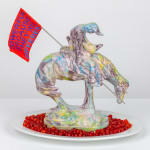Jeffrey Gibson USA, b. 1972
POWERFUL BECAUSE THEY’RE DIFFERENT , 2021
Porcelain, Pottery Glaze, Steel Rod, Acrylic Chiffon, Glass Beads, Porcelain Base
14 x 12 x 6 in
35.6 x 30.5 x 15.2 cm
35.6 x 30.5 x 15.2 cm
7996
Further images
-
(View a larger image of thumbnail 1
)

-
(View a larger image of thumbnail 2
)

-
(View a larger image of thumbnail 3
)

-
(View a larger image of thumbnail 4
)

-
(View a larger image of thumbnail 5
)

-
(View a larger image of thumbnail 6
)

-
(View a larger image of thumbnail 7
)

-
(View a larger image of thumbnail 8
)

-
(View a larger image of thumbnail 9
)

Powerful Because They're Different, by Jeffrey Gibson, may be instantly recognizable to many viewers. It is based on one of the most frequently reproduced images of an Indigenous American, a...
Powerful Because They're Different, by Jeffrey Gibson, may be instantly recognizable to many viewers. It is based on one of the most frequently reproduced images of an Indigenous American, a work titled The End of the Trail, by James Earle Fraser. The original Fraser sculpture shows a slumped over rider on the back of a horse, in a position suggestive of exhaustion or defeat. In his adaptation of the work, Gibson deftly re-imagines the essence of the figure, altering the original spear into a flag bearing a message of empowerment, and covering the entire form in a luminous, melting, multicolored glaze. In this new manifestation, the figure and horse may be taking a bow or dancing, captured in a moment of introspective delight.
Gibson (b. 1972, USA) is a member of the Chocktaw and Cherokee nations. His aesthetic position is rooted in the spaces where narratives collide. The work re-contextualizes relationships between popular culture, identity politics, personal experience, memory, and canonized versions of history, inviting viewers to question the myths and assumptions that empower contemporary social structures.
Gibson (b. 1972, USA) is a member of the Chocktaw and Cherokee nations. His aesthetic position is rooted in the spaces where narratives collide. The work re-contextualizes relationships between popular culture, identity politics, personal experience, memory, and canonized versions of history, inviting viewers to question the myths and assumptions that empower contemporary social structures.
Provenance
Artist StudioKavi Gupta Gallery








